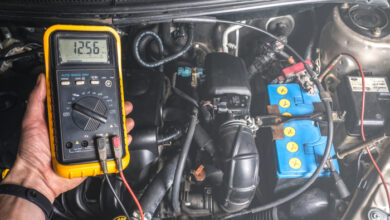How Often Should I Rotate My Tires?

How often should I rotate my tires is a common question so in this guide we’ll cover everything you need to know about rotating tires and what to look for.
Tire safety should be the number one concern for everyone who spends any time driving on the city streets and highways.
According to productsafety.com, over 78,000 crashes and 400 deaths are caused by tire blowouts in the United States each year.
Therefore, to keep you and everyone around you safe while driving, it is very important that you pay close attention to regular tire care and maintenance.
A huge part of tire care is rotating your tires. To make sure you are following the recommended rules and guidelines for tire rotation, here are 3 essential things that you should know.
1. Why you should rotate your tires?
The average vehicle owner may or may not rotate their tires on a regularly scheduled basis, if at all. For some people, one of the primary reasons for neglecting this part of car maintenance is often lack of awareness.
To assist in combating these issues, here are 6 essential reasons why you should always rotate your tires regularly.
- More Even Tire Treads
- Longer Tire Life
- Better Safety
- Improved Performance
- The health of Other Components
- Preserve Balanced Handling and Maintain traction
Each of these reasons combined is meant to make sure you are always safe on the road, while also helping you to save money on premature car tire replacements.
2. When You Should Rotate Your Tires
When should you rotate the tires on your vehicle? Even though the standard answer is usually every 3,000 to 5,000 miles, there are several factors that must be taken into consideration.
To find the best answer for your vehicle, you should review the following:
- Use the recommendations from your car’s owner’s manual
- Schedule a rotation every time you change your oil
- Base Schedule on Vehicle’s drive train (i.e. front-wheel drive, rear-wheel drive, All wheel drive)
As you see, this answer is dependent on more than one factor. For example, you may want to base your tire rotation on your vehicle’s drive train, especially since the tires wear out differently based on their position.
Simply stated, you can expect the front tires on the vehicle to wear out quicker than the back tires if it has front-wheel drive.
This is also why you need to consider all of these factors prior to making your own tire rotation schedule.
3. How to rotate your tires
Prepare Your Vehicle for the Rotation
1. Gather the Required Tools
- Lug Wrench
- Car Jack
- Jack Stand
2. Park Vehicle on Level Ground – (i.e. preferably on asphalt or concrete driveway)
3. Read Owner’s Manual Instructions to Raise the Vehicle Off of the Ground – These instructions will be based on the type of jack and jacks stands that you are using.
4. Choose the Appropriate Pattern for Rotating Your Tires
Once you have determined the appropriate rotation schedule for your vehicle, follow the Tire Industry’s Association instructions on how to rotate your tires.
When you read these instructions, they will explain each of the guidelines that should be used since there are 3 rotational patterns that apply to the majority of today’s vehicles.
Choose the pattern that fits your particular vehicle’s drive train (i.e. Front -drive, Rear-drive, all-wheel drive).
Before rotating your tires, look for the sizes on the front and the rear of your vehicle to make sure that the sizes are the exact same.
These tires must also rotate in only one direction to achieve the proper results. Having said this, use one of the 3 rotational patterns that fit your particular vehicle.
Rotational Pattern #1 – Front Drive Vehicles
When changing out a front-drive vehicle, swap out the front tires with the rear tires. For instance, after you remove the front tires from your vehicle, move these tires to the rear position on the same side.
Once this part of the rotation is complete, take your rear tires to the opposite corners on the front of your vehicle.
Rotational Pattern #2 – Rear Drive Vehicles
When changing out a rear-drive vehicle, swap out the rear tires with the front tires. For instance, after you remove the rear tires from your vehicle, move these tires to the front position on the same side.
Once this part of the rotation is complete, take your front tires to the opposite corners on the rear of your vehicle.
Rotational Pattern #3 – All-Wheel Drive Vehicles
When changing out an all-wheel-drive vehicle, use a criss-cross pattern with all 4 tires.
For instance, here are the 4 iterations that you should follow:
- Remove the right front tire to the Left rear of the vehicle
- Remove the left front tire to the right rear of the vehicle
- Remove the left rear tire to the right front of the vehicle
- Remove the right rear tire to the left front of the vehicle
Bottom Line
Rotating your tires regularly is not only about reducing the wear and tear on your tires.
Actually, there is a lot more involved in keeping these schedules consistently for the life of your car. One of the most important is reducing the number of vehicle accidents from bad tire problems like tire blowouts.
By following the recommended rotation schedules for your vehicle, you can also save money by reducing the wear and tear that prematurely ages your treads.



